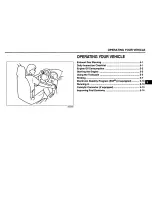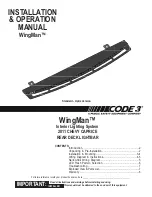
345
Operation
Tires and wheels
Warning!
G
Each tire, including the Minispare, should be
checked monthly when cold and inflated to
the inflation pressure recommended by the
vehicle manufacturer on the Tire and
Loading Information placard or, if available,
on the tire inflation pressure label. If your ve-
hicle has tires of a different size than the
size indicated on the Tire and Loading
Information placard or, if available, the tire
inflation pressure label, you should deter-
mine the proper tire inflation pressure for
those tires.
As an added safety feature, your vehicle has
been equipped with a tire pressure monitor-
ing system (TPMS) that illuminates a low tire
pressure telltale when one or more of your
tires is significantly underinflated. Accord-
ingly, when the low tire pressure telltale illu-
minates, you should stop and check your
tires as soon as possible, and inflate them to
the proper pressure. Driving on a significant-
ly underinflated tire causes the tire to over-
heat and can lead to tire failure.
Underinflation also reduces fuel efficiency
and tire tread life, and may affect the vehi-
cle’s handling and stopping ability. Please
note that the TPMS is not a substitute for
proper tire maintenance, and it is the driv-
er’s responsibility to maintain correct tire
pressure, even if underinflation has not
reached the level to trigger illumination of
the TPMS low tire pressure telltale.
Your vehicle has also been equipped with a
TPMS malfunction indicator to indicate
when the system is not operating properly.
The TPMS malfunction indicator is com-
bined with the low tire pressure telltale.
When the system detects a malfunction, the
telltale will flash for approximately 1 minute
and then remain continuously illuminated.
This sequence will continue upon subse-
quent vehicle start-ups as long as the mal-
function exists. When the malfunction
indicator is illuminated, the system may not
be able to detect or signal low tire pressure
as intended.
TPMS malfunctions may occur for a variety
of reasons, including the installation of
replacement or alternate tires or wheels on
the vehicle that prevent the TPMS from
functioning properly. Always check the
TPMS malfunction telltale after replacing
one or more tires or wheels on your vehicle
to ensure that the replacement or alternate
tires and wheels allow the TPMS to continue
to function properly.
i
If a condition causing the TPMS to malfunc-
tion develops, it may take up to 10 minutes
for the system to signal a malfunction using
the TPMS telltale flashing and illumination
sequence.
The telltale extinguishes after a few minutes
driving if the malfunction has been corrected.
i
Operating radio transmission equipment
(e.g. wireless headsets, two-way radios) in or
near the vehicle could cause the TPMS to
malfunction.
Summary of Contents for 2008 C 230
Page 21: ...20 At a glance Exterior view ...
Page 23: ...22 At a glance Storage compartments ...
Page 25: ...24 At a glance Cockpit ...
Page 27: ...26 At a glance Instrument cluster ...
Page 34: ...33 Safety and Security Occupant safety Panic alarm Driving safety systems Anti theft systems ...
Page 69: ...68 ...
Page 179: ...178 Controls in detail Audio system Audio control unit overview ...
Page 309: ...308 ...
Page 509: ......
















































